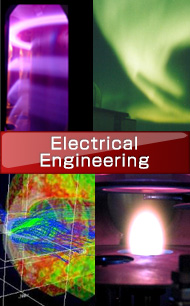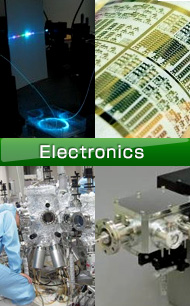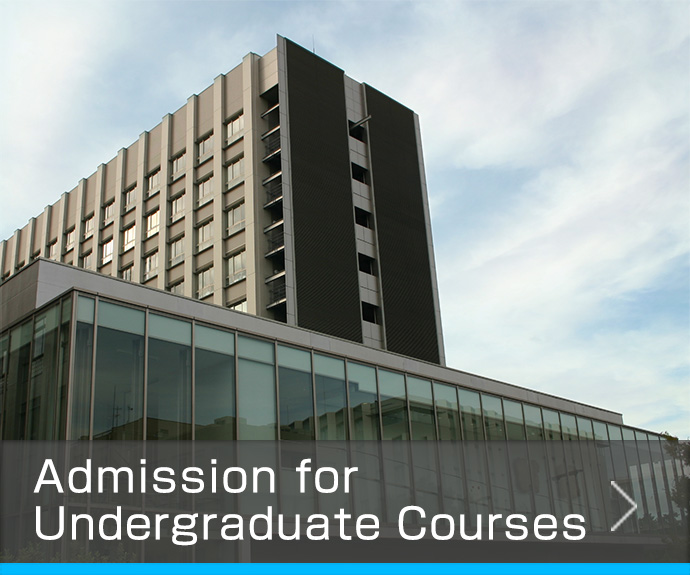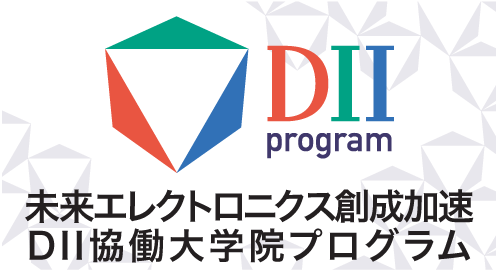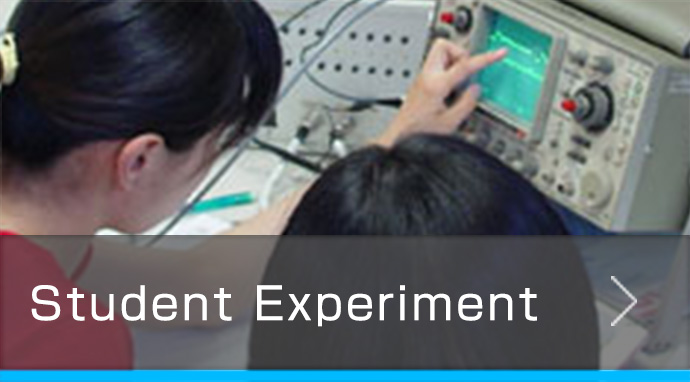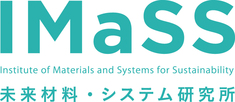
009
Ikarashi Laboratory is engaged in research on cutting-edge semiconductor device materials using atomic-resolution analysis.
Details are here

- (Left and center) HAADF-STEM images of monolayer-MoS2/α-Al2O3 viewed in [1100] and [1120] directions of α-Al2O3. Atomic models of MoS2 and Al2O3 are overlaid. (Right) Experimentally determined atomic positions of MoS2 on α-Al2O3 stacking structure viewed in [0001] direction. Dotted and dashed lines indicate the Al atomic plane of α-Al2O3 and correspond to those in micrographs.
008
Wide bandgap devices such as silicon carbide (SiC) devices have been widely employed due to their higher switching speed and switching frequency compared to silicon devices [1]-[2]. Nevertheless, these characteristics make it more sensitive to parasitic components and causes electromagnetic interference (EMI). Power electronics laboratory have been conducting various research on low-noise and high-reliability power modules.
This study proposes a novel power module to reduce the CM noise. The proposed module replaces a specific area with a low-permittivity material to reduce the CM capacitance between the pulsating nodes and a grounded baseplate.
[1] S. Choi, J. Choi, T. Warnakulasooriya, J. -W. Shin, J. Imaoka and M. Yamamoto, "Improved Packaging of Power Module With Low-Permittivity Material for Low Common-Mode Noise and High Reliability," in IEEE Transactions on Power Electronics, vol. 39, no. 11, pp. 14261-14270, Nov. 2024, doi: 10.1109/TPEL.2024.3438831.
[2] S. Choi, J. Choi, T. Warnakulasooriya, J. -W. Shin, J. Imaoka and M. Yamamoto, "Utilizing Silicone Gel Encapsulation in Power Semiconductor Module to Improve Manufacturability while Reducing Common-Mode Noise," in IEEE Transactions on Power Electronics, doi: 10.1109/TPEL.2025.3617463.

007
Zero-Field STT Assisted SOT Magnetization Switching in Perpendicularly Magnetized Memory Layer - Demonstration of a Writing Scheme for Ultra High Capacity 3D Magnetic Memory -
Kato Laboratory at the Department of Electronics, Graduate School of Engineering, Nagoya University (a collaborative laboratory at the Institute of Materials and Systems for Sustainability) has successfully demonstrated zero-field magnetization switching in a perpendicularly magnetized Co/Pd memory layer using a giant magnetoresistance (GMR) pillar device. By simultaneously applying Spin Transfer Torque (STT) and Spin Orbit Torque (SOT), magnetization reversal without an external magnetic field was confirmed. The STT assisted SOT switching is a promising writing scheme for high-speed, large-capacity 3 dimensional (3D) magnetic memory.
In high-speed and large-scale information processing systems, a major bottleneck lies in the three orders of magnitude speed gap between main memory and flash memory in the memory hierarchy. To overcome this problem, 3D magnetic memory (Fig. 1) is attracting attention as a next-generation high-speed, high-density non-volatile memory. In the 3D magnetic memory, zero-field STT assisted SOT magnetization switching is considered as a data writing scheme.
To verify this writing scheme, Kato Laboratory investigated STT-assisted SOT magnetization switching in GMR pillar devices with perpendicularly magnetized Co/Pd memory stacks. We demonstrated that zero-field SOT magnetization switching can be achieved with STT assistance, and that STT current significantly reduces the required SOT switching current [1] (Fig. 2). Furthermore, we showed that even in synthetic ferrimagnetic memory layers, which are robust from stray field interference and suitable for high-density magnetic memory, zero-field STT assisted SOT switching is achieved similar to the case of ferromagnetic memory layers [2].
These findings demonstrate a writing scheme for 3D magnetic memory using Co/Pd memory layers, which offer excellent thermal stability and minimal magnetic interference. This work represents a significant contribution to the technological advancement of ultra-high-density magnetic random access memory.
[1] D. Pan et al., IEEE Trans. Magn. 59, 4100505 (2023).
[2] D. Pan et al., J. Magn. Magn. Mater. 618, 172872 (2025).

- Fig. 1 Schematic of 3-dimentional magnetic memory. STT assisted SOT reverse the magnetization of the bit adjacent to the word line. The written bit (domain) is shifted by STT current though the magnetic pillar and the magnetization direction of the bottom bit is read by TMR effect of MTJ.

- Fig. 2 SOT current density as a function of the STT assist current density measured for the CPP-GMR device with a Co/Pd multilayer memory stack. AP-P and P-AP indicate the magnetization transitions between memory and reference layers from antiparallel (AP) to parallel (P) and P to AP, respectively. Both STT and SOT current densities were normalized by their respective critical switching densities. Note that no in-plane external field Hx was not applied during the switching.
006
Space Information Engineering Laboratory (Miyoshi Lab), Department of Electrical Engineering, is conducting fundamental research on space weather forecasting.
In this laboratory, we are conducting fundamental research to understand and predict the space environment using satellite data analysis, numerical simulations on supercomputers, machine learning, and data assimilation.

- Left: A machine learning model that predicts the near-Earth space radiation environment based on continuous solar wind observations.
- Right: Plasma simulations above sunspots performed with a supercomputer "Fugaku".
005
This group, in collaboration with Asahi Kasei Corporation, has succeeded in achieving CW oscillation at RT of a UV-C LD with a wavelength of 274 nm for the first time in the world. They have launched a start-up company called ULTEC to accelerate its implementation in society.
Details are here
Details are here

- RT CW operation of UV-C LD with a wavelength of 274 nm
004
Shiokawa Laboratory in Department of Electrical Engineering conducts ionospheric research using Global Navigation Satellite System (GNSS) including GPS.
Radio signals transmitted from GNSS satellites pass through the Earth's atmosphere and are received by ground-based receivers. By analyzing how these signals are affected, we can estimate the electron content in the ionosphere. We have developed a novel 3-D tomography technique and successfully revealed the three-dimensional structure of ionospheric variations.
Details are here

- Top: Horizontal 2-D distribution of ionospheric disturbances over Japan derived from GNSS observations. Bottom: Vertical and horizontal electron density structures reconstructed using three-dimensional ionospheric tomography.
003
Advancing AI Model of Superconducting Tape Production for Smarter Manufacturing
Yoshida Laboratory in Department of Electrical Engineering has developed an artificial intelligence (AI) model for manufacturing. This model remains effective even when manufacturing equipment changes.
Superconducting materials are indispensable for the development of nuclear fusion, electric aircraft, and MRI (magnetic resonance imaging). Superconducting tapes should be produced in large quantities and at low cost to meet growing demand. However, the control of their structure and properties is extremely delicate, and for many years, optimization has relied on the experience and intuition of skilled engineers. In recent years, efforts have begun to be made to increase manufacturing efficiency using artificial intelligence (AI).
Even when the same materials are fabricated, different manufacturing equipment and detailed adjustments make it difficult to construct an AI model. This research focused on the consistency of the process phenomena. By analyzing data obtained from various deposition equipment units, we were able to model the consistent process characteristics. This achievement opens more efficient AI-driven optimization in process development not only for superconducting wires but also for various other materials.
The research results have been published in Communications Engineering, a scientific journal from Springer Nature.
Details are here
Details are here

- Fig. A single model describes dependence of superconducting property on deposition temperature. The data was obtained from sample series deposited using different deposition equipment units.
002
Kawase Laboratory, Department of Electronics, is working on the development of technology for generating, detecting and applying terahertz waves.
The terahertz (THz) waves being researched in the Kawase Laboratory have the characteristics of both radio wave permeability and the ease of handling light waves, and they exhibit absorption spectra specific to reagents, and unlike X-rays, they are also safe for the human body, so they are expected to have various applications, such as testing for illegal drugs hidden in mail.
[1] K. Murate, S. Mine, and K. Kawase, "Wide dynamic range and real-time reagent identification and imaging using multi-wavelength terahertz parametric generation and machine learning," Scientific Reports, vol. 13, Article number 12743 (2023). DOI:10.1038/s41598-023-40013-y
[2] K. Murate, S. Mine, and K. Kawase, "Terahertz Parametric Generators and Detectors for Nondestructive Testing Through High-Attenuation Packaging Materials," IEEE Journal of Selected Topics in Quantum Electronics, vol. 29, issue 5, Article number 8500813 (2023). DOI:10.1109/JSTQE.2023.3296989

- Various THz-related research led by Prof. Kawase and Associate Prof. Murate
001
The formation process of amino acid precursors from molecular clouds was simulated by the reactive force field molecular dynamics method
There is a bottom-up scenario in which a chemical reaction in a cosmic molecular cloud is a candidate for forming organic molecules that constitute life on the Earth. We are searching for reaction pathways using molecular dynamics methods with a reaction force field simulating a molecular cloud.

- Figure: After the temperature of a random arrangement of carbon, nitrogen, oxygen, and hydrogen is decreased from high temperature, the atoms are linked by covalent bonds to form various molecules. The fact that organic molecules are also synthesized among them was investigated using reaction force field molecular dynamics.






